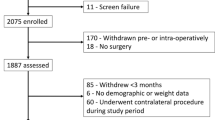Abstract
We reviewed patients who had undergone total hip arthroplasties between January 2000 and October 2002 in order to determine whether a high body mass index (BMI) results in an increase in complications or re-operations. We compared 179 hip arthroplasties in 162 patients with an average BMI of 22.5 (18.6–24.9) with 164 hip arthroplasties in 151 age-matched patients with an average BMI of 33.3 (30–39.6). There was no difference in satisfaction between obese and non-obese patients following arthroplasty using a self-administered validated questionnaire (obese = 91%, non-obese = 93%, p=0.84). At a minimum of one year follow up, there was no statistically significant difference in the rates of complication (obese = 8.7%, non-obese = 7.6%, p=0.76) or revision surgery (obese = 3.6%, non-obese = 3.2%, p=0.85). In the short term a BMI >30 plays no role in an increase in complications or re-operation.
Résumé
Nous avons revus des malades qui avaient subi une arthroplastie totale de la hanche entre janvier 2000 et octobre 2002 pour déterminer si un index de masse corporelle (BMI) élevé s’accompagnait d’une augmentation des complications ou des réinterventions. Nous avons comparé 179 arthroplasties de la hanche chez 162 malades avec un BMI moyen de 22,5 (18,6–24,9) avec 164 arthroplasties de la hanche chez 151 patients d’âge équivalent avec un BMI moyen de 33,3 (30–39,6). Il n’y avait aucune différence dans la satisfaction après l’arthroplastie entre obèses et non obèses en utilisant un questionnaire validé auto-administré (obèse = 91%, non obèse = 93%, p=0.84). À un minimum d’une année de suivi, il n’y avait aucune différence dans les taux de complication (obèse = 8,7%, non obèse = 7,6%, p=0,76) ou de chirurgie de révision (obèse = 3,6%, non obèse = 3,2%, p=0,85). Dans le court terme un BMI >30 n’a pas d’importance dans la fréquence des complications ou des réinterventions.
Similar content being viewed by others
References
Anderson L, Kammerer WS, Greer RB III (1979) Risk factor assessment in 101 total hip arthroplasties. Clin Orthop 141:50–54
Bostman OM (1994) Prevalence of obesity among patients admitted for elective orthopaedic surgery. Int J Obes 18:709–713
Bowditch MG, Villar RN (1999) Do obese patients bleed more? A prospective study of blood loss at total hip replacement. Ann R Coll Surg Eng 81:198–200
Burton BT, Foster WR, Hirsch J, Van Itallie TB (1985) Health implications of obesity: an NIH consensus development conference. Int J Obes 9:155–170
Chan CLH, Villar RN (1996) Obesity and quality of life after primary hip arthroplasty. J Bone Jt Surg Br 78:78–81
Chao EYS, Coventry MB (1981) Fracture of the femoral component after total hip replacement. An analysis of fifty-eight cases. J Bone Jt Surg Am 63:1078–1094
Epstein AM, Read L, Hoefer M (1987) The relation of body weight to length of stay and charges for hospital services for patients undergoing elective surgery: a study of two procedures. Am J Public Health 77:993–997
Jiganti JJ, Goldstein WM, Williams CS (1993) A comparison of the perioperative morbidity in total joint arthroplasty in the obese and nonobese patient. Clin Orthop 289:175–179
Karlson EW, Mandl LA, Aweh GN, Sangha O, Liang MH, Grodstein F (2003) Total hip replacement due to osteoarthritis: the importance of age, obesity, and other modifiable risk factors. Am J Med 114:93–98
Lehman DE, Capello WN, Feinberg JR (1994) Total hip arthroplasty without cement in obese patients. A minimum two-year clinical and radiographic follow-up study. J Bone Jt Surg Am 76:854–862
Soballe K, Christensen F, Luxhoj T (1987) Hip replacements in obese patients. Acta Orthop Scand 58:223–225
Strauss RJ, Wise L (1978) Operative risks of obesity. Surg Gynecol Obstet 146:286–291
Surin VV, Sundholm K (1983) Survival of patients and prostheses after total hip arthroplasty. Clin Orthop 177:148–153
van Saase JL, Vandenbroucke JP, van Romunde LK, Valkenburg HA (1998) Osteoarthritis and obesity in the general population. A relationship calling for an explanation. J Rheumatol 15:1152–1158
Author information
Authors and Affiliations
Corresponding author
Rights and permissions
About this article
Cite this article
Ibrahim, T., Hobson, S., Beiri, A. et al. No influence of body mass index on early outcome following total hip arthroplasty. International Orthopaedics (SICO 29, 359–361 (2005). https://doi.org/10.1007/s00264-005-0012-8
Received:
Accepted:
Published:
Issue Date:
DOI: https://doi.org/10.1007/s00264-005-0012-8




